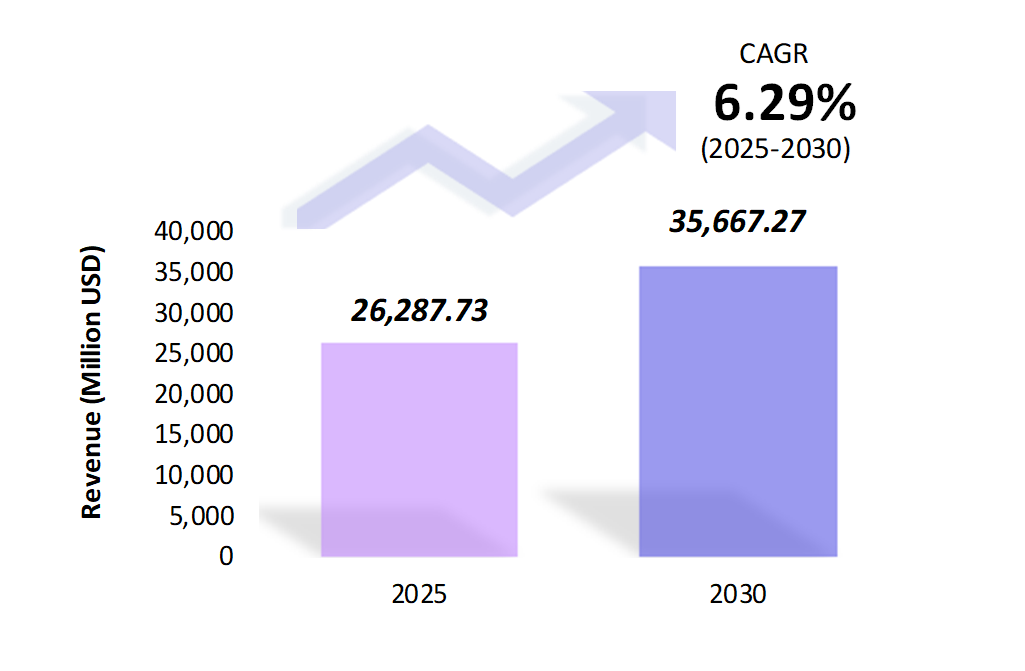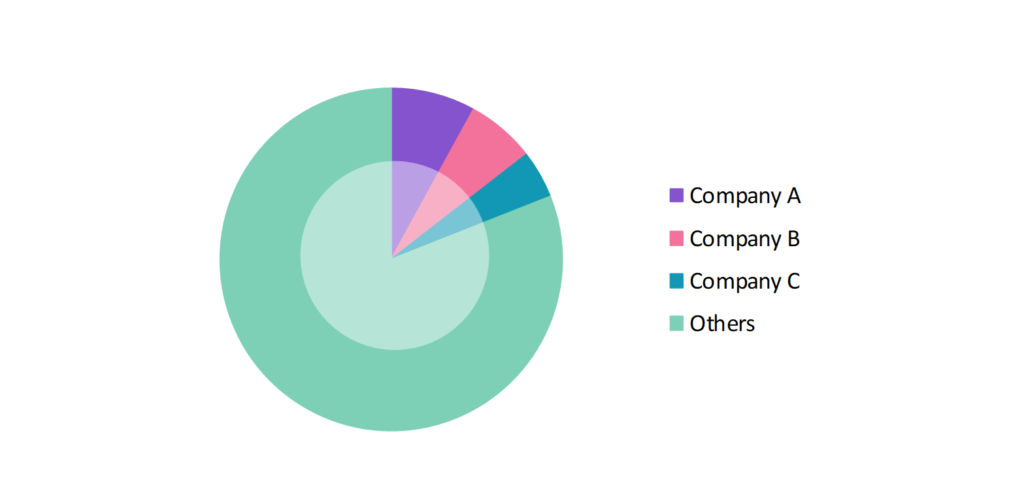Mobile Food Services Market Outlook: Size, Share, Trends & Growth Analysis (2024-2029)
The market report presents a thorough analysis segmented by Application (Food Truck, Removable Container); by Product (Food, Beverages); by Geography (North America, South America, Asia Pacific, Europe, The Middle East, Africa).
Outlook

- The mobile food services market is estimated to be at USD 26,287.73 Mn in 2025 and is anticipated to reach USD 35,667.27 Mn in 2030.
- The mobile food services market is registering a CAGR of 6.29% during the forecast period 2025-2030.
- The mobile food services market, encompassing food trucks, carts, and trailers, is experiencing robust growth due to rising consumer demand for convenient, unique, and affordable dining experiences. This market is fueled by changing consumer lifestyles, particularly the preference for on-the-go meals.
Request a free sample.
Ecosystem

- The participants in the global mobile food services industry are always developing their strategies to preserve a competitive advantage.
- These companies primarily use acquisitions, research & developments, investments, partnerships, and technological launches.
- Several important entities in the mobile food services market include Kogi BBQ; Phat Cart; Luke’s Lobster; Food Truck Pages; Wafels and Dinges; and others.
Ask for customization.
Findings
| Attributes | Values |
|---|---|
| Historical Period | 2019-2023 |
| Base Year | 2024 |
| Forecast Period | 2025-2030 |
| Market Size (2025) | USD 26,287.73 Mn |
| Market Size (2030) | USD 35,667.27 Mn |
| Growth Rate | 6.29% CAGR from 2025 to 2030 |
| Key Segments | Application (Food Truck, Removable Container); Product (Food, Beverages); Geography (North America, South America, Asia Pacific, Europe, The Middle East, Africa) |
| Key Vendors | Kogi BBQ; Phat Cart; Luke’s Lobster; Food Truck Pages; Wafels and Dinges |
| Key Countries | The US; Canada; Mexico; Brazil; Argentina; Colombia; China; India; Singapore; The UK; Germany; France; UAE; Saudi Arabia; Egypt; South Africa |
| Largest Market | North America |
Get a free quote.
Trends
- Integration of Digital Ordering and Payments: Technology adoption in mobile food services is on the rise as vendors embrace digital ordering platforms and mobile payment systems to enhance their operations. These tools help streamline transactions, making the ordering and payment process more efficient for both customers and vendors. As a result, food service providers can offer faster, more convenient experiences, meeting the growing demand for digital solutions in the food industry. This shift towards technology also allows for smoother management and tracking of orders in real time.
- Diverse and Innovative Menu Offerings: Mobile food vendors are expanding their menus to cater to various tastes, including vegan, gluten-free, and ethnic cuisines. This diversity attracts a broader customer base looking for unique and health-conscious options. For example, in 2023, food trucks in the US introduced plant-based alternatives to traditional fast food, appealing to the growing demand for sustainable dining choices.
- Emphasis on Sustainable Practices: Many mobile food services are adopting eco-friendly practices, such as compostable packaging and locally sourced ingredients, to reduce their environmental footprint. In 2023, food trucks in California increasingly used biodegradable utensils and containers to align with state-wide sustainability regulations implemented.
Speak to analyst.
Catalysts
- Rising Demand for Street Food in Emerging Markets: Emerging markets, particularly Asia and Latin America, are seeing increased demand for affordable, high-quality street food. In 2022, India’s street food market recorded significant growth, fueled by expanding middle-class income and urbanization, providing substantial growth opportunities for mobile food services.
- Low Operational Costs and Flexibility: A significant market driver in the mobile food services sector is the lower startup and operational costs compared to traditional restaurants. This cost advantage attracts new entrepreneurs, allowing them to enter the market with less financial risk. The reduced overhead expenses also enable faster scalability, facilitating rapid expansion into new locations. As a result, the mobile food services market is experiencing significant growth, driven by these cost efficiencies and the opportunities they create for business expansion.
- Supportive Government Regulations and Permits: A significant market driver for the mobile food industry is the growing shift of cities relaxing regulations and creating more supportive environments for food vendors. By streamlining permit processes, reducing fees, and designating specific zones for mobile food operations, cities are making it easier for food trucks and carts to enter and thrive in urban markets. This regulatory shift supports local economies and encourages innovation in the food sector, fueling growth and attracting new vendors to meet the increasing demand for diverse food options. For instance, in 2023, New York City launched a program to issue more food truck permits, allowing more operators into the market while supporting local entrepreneurship.
Inquire before buying.
Restraints
- Weather-Dependent Sales and Seasonal Limitations: A significant challenge in the mobile food services market is the impact of weather conditions on operations. Adverse weather, such as rain, extreme temperatures, or storms, can limit vendors’ ability to operate, reducing foot traffic and sales. Additionally, off-peak seasons or holidays often bring lower customer demand, further restricting operational capacity. These external factors create variability in revenue and present ongoing challenges for mobile food vendors in maintaining consistent business performance.
- Rising Costs of Ingredients and Supplies: The mobile food services market is experiencing an escalating cost of ingredients and packaging materials caused by inflation and disruptions in the supply chain. These rising expenses are narrowing profit margins for food truck operators, making it more challenging to remain profitable. In response, operators may need to raise prices or adjust their offerings, which could lead to a decline in customer demand. These financial pressures contribute to uncertainty and operational challenges for mobile food vendors.
- Stringent Health and Safety Regulations: Mobile food operators face strict health codes and safety regulations, which vary by region and can be challenging to navigate. For example, in 2023, Chicago increased health inspection frequency for food trucks, resulting in higher compliance costs for vendors aiming to meet sanitation standards.
Personalize this research.
Hotspot

Explore purchase options.
Table of Contents
| 1. Introduction 1.1. Research Methodology 1.2. Scope of the Study 2. Market Overview / Executive Summary 2.1. Global Mobile Food Services Market (2019 – 2023) 2.2. Global Mobile Food Services Market (2024 – 2030) 3. Market Segmentation 3.1. Global Mobile Food Services Market by Application 3.1.1. Food Truck 3.1.2. Removable Container 3.2. Global Mobile Food Services Market by Product 3.2.1. Food 3.2.2. Beverages 4. Regional Segmentation 4.1. North America 4.1.1. The US 4.1.2. Canada 4.1.3. Mexico 4.2. South America 4.2.1. Brazil 4.2.2. Argentina 4.2.3. Colombia 4.2.4. Rest of South America 4.3. Asia Pacific 4.3.1. China 4.3.2. India 4.3.3. Singapore 4.3.4. Rest of Asia Pacific 4.4. Europe 4.4.1. The UK 4.4.2. Germany 4.4.3. France 4.4.4. Rest of Europe 4.5. The Middle East 4.5.1. UAE 4.5.2. Saudi Arabia 4.5.3. Rest of the Middle East 4.6. Africa 4.6.1. Egypt 4.6.2. South Africa 4.6.3. Rest of Africa 5. Value Chain Analysis of the Global Mobile Food Services Market 6. Porter Five Forces Analysis 6.1. Threats of New Entrants 6.2. Threats of Substitutes 6.3. Bargaining Power of Buyers 6.4. Bargaining Power of Suppliers 6.5. Competition in the Industry 7. Trends, Drivers and Challenges Analysis 7.1. Market Trends 7.1.1. Market Trend 1 7.1.2. Market Trend 2 7.1.3. Market Trend 3 7.2. Market Drivers 7.2.1. Market Driver 1 7.2.2. Market Driver 2 7.2.3. Market Driver 3 7.3. Market Challenges 7.3.1. Market Challenge 1 7.3.2. Market Challenge 2 7.3.3. Market Challenge 3 8. Opportunities Analysis 8.1. Market Opportunity 1 8.2. Market Opportunity 2 8.3. Market Opportunity 3 9. Competitive Landscape 9.1. Kogi BBQ 9.2. Phat Cart 9.3. Luke’s Lobster 9.4. Food Truck Pages 9.5. Wafels and Dinges 9.6. Company 6 9.7. Company 7 9.8. Company 8 9.9. Company 9 9.10. Company 10 |
Know the research methodology.
Mobile Food Services Market – FAQs
1. What is the current size of the mobile food services market?
Ans. In 2025, the mobile food services market size is USD 26,287.73 Mn.
2. Who are the major vendors in the mobile food services market?
Ans. The major vendors in the mobile food services market are Kogi BBQ; Phat Cart; Luke’s Lobster; Food Truck Pages; Wafels and Dinges.
3. Which segments are covered under the mobile food services market segments analysis?
Ans. The mobile food services market report offers in-depth insights into Application, Product, and Geography.
